|
 The State of New York - NY Capitol Building ceiling, Albany, NY Posted by:  sagefemme sagefemme
N 42° 39.167 W 073° 45.429
18T E 601871 N 4723006
This is a very ornate mural on a domed ceiling on the second floor of the Capitol building in a room called the Governor's Reception Room. Listed in the Smithsonian Institution Research Information System (SIRIS) art Inventory.
Waymark Code: WMGHQH
Location: New York, United States
Date Posted: 03/09/2013
Views: 7
William deLeftwich Dodge painted this mural in panels in his studio anticipating that it would be viewed from a distance of 40 feet, from the floor of the flag room on the first floor. However, removing the second floor floor proved to be impractical. As a result, the mural is a little hard to take in, but viewers have an unusual opportunity to see a work of great magnitude close up.
Called "The State of New York", dated 1928, it is composed of 20 distinct panels depicting the history of New York from early settlement to World War I. I will use the description of each panel from a poster/pamphlet published by the NY State Office of General Services, using a schematic provided to identify each panel.
The default image contains segments 1 and 8. The central figure is a woman, representing alternately the "Goddess of Harmony" and the "Spirit of New York", a goddess of both war and peace. Dodge's daughter Sarah Dodge Kimbrough was the model for this figure.
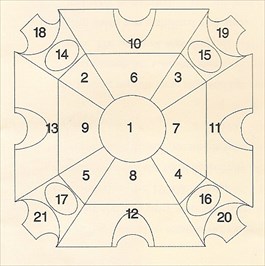
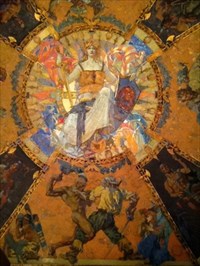
8 Indian-French French fur traders (courier du bois) were among the first European explorers of New York State. As they traveled throughout the state, they came into frequent contact with the native Indian tribes. Many complex treaties and trading arrangements were established and violated. In this painting, an Indian warrior struggles with a Frenchman. The Indian fights heroically, but the Frenchman has the upper hand. The woman in the lower left carries a child on her back, and the combined effect seems to show that the Indian is fighting in defense of his home and family. The French goddess of victory, however cradles a rooster and carries a flag emblazoned with the French fleur-de-lis.
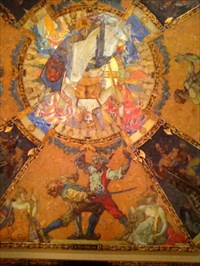
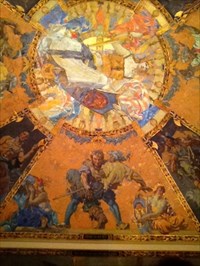
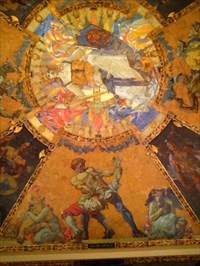
6 Dutch-English By the end of the 17th century, all of New Netherland was property of the British crown. Throughout the 1600s, the French, Dutch, and English fought repeatedly for control of the region. For a period during the 1670s, the English and French actually joined forces, attacking New Netherland from all sides. After the region changed hands five times within a quarter century, English authority was established in 1691. In this painting an Englishman delivers the death stroke to the Dutch. the Dutch woman now holds her sword point down in a demonstration of submission, while the English figure holds her sword blade up and pets a lion, the symbol of the British crown.
7 French-DutchIn 1609, Henry Hudson sailed his ship, the Half Moon, up the riveer which now bears his name. He claimed what is now present-day Albany and "downstate" for the Dutch. By 1614, the Dutch trading post of Fort Nassau was established at present-day Albany. The French and Dutch co-existed for some time, but by the mid-17th century, the Dutch controlled much of Central New York and the Hudson Valley. New York's Dutch heritage is still evident in site names from Brookly to Rensselaer. This panel depicts the dominance of the Dutch. The French woman on the left cowers to protect the rooster, while the Dutch icon offers a sword to the fighting Dutchman. the Dutch colonist in this painting is distinguishable by his wooden clogs, a characteristic of Dutch dress.
9 English-AmericanThis panel marks the end of colonial rule in New York State. The "American" depicted here is the result of several centuries of contact between the various settlers of the area. His bare-chested display of brute strength is very similar to the Indian of the first panel. The two men are engaged in hand-to-hand combat, with no weapons evident. In the lower left, the English lion is in its death throes, while in the lower right the American eagle is poised for flight.
In each corner are images depicting the Five Nations of the Iroquois. According to Iroquois tradition, the Iroquois Confederacy, or "Great League of Peace" existed long before the arrival of Europeans on the North American continent. The Mohawk, Onondaga, Cayuga, Aneida, and Seneca Nations united under the leadership of Hiawatha and the Peacemaker to end years of feuding.
2 Onondaga The vultures and skulls on either side of the man may represent the legendary shaman and cannibal Thadodaho. The Peacemaker and Hiawatha pacified Thadodaho when they unified the nations. Thadodaho was also a member of the Bear Clan, and this symbol is in the painting as well, between the warrior's feet.
3 Mohawk The Mohawk here carries a slain deer, a mainstay of Native American diet. Just as the Plains Indians used every part of the buffalo, the Iroquois let no part of the deer go to waste. On his bel, the warrior carries a stone ax, a common tool and weapon and the precursor of the tomahawk. The bear claw necklace and bone breastplate the Indian wears were commonly found among Plains Indians. On either side of the Indian are wolves, another Iroquois clan symbol.
4 Oneida(Oncidias) and Seneca (Cenicos) The herons and the beaver represent clans of the Iroquois Nations. There were several clans, and people of the same clan could be found living in different villages, and among several nations. This provided an extended kinship network for travelers. The kneeling Indian holds a peace pipe, a ceremonial object peopularly associated with Plains Indians during Dodge's time. The shield and bear claw necklace are also identified with the Plains Indian.
5 Cayuga (Cycugas) The Cayuga warrior wears a loincloth with a turtle on it, another clan symbol. The turtle also played an important role in Native American mythology. The Iroquois creation tradition refers to the earth as an island supported by the back of a huge turtle.
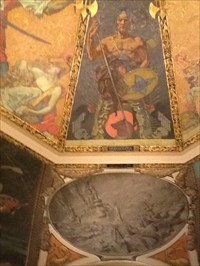
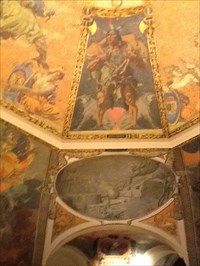

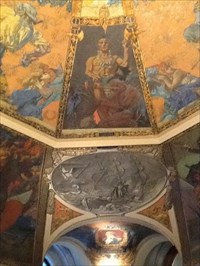
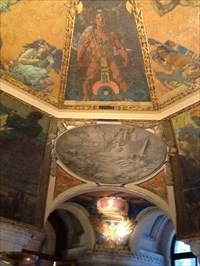
Naval Engagements .
14 Sinking of Cervera's Fleet Under the command of Admiral Cervera, the Spanish fleet attempted to leave the Santiago de Cuba harbor on July 3, 1898. American ships were waiting for this move, and had blockaded the exit of the harbor. Among these ships were the New York and the Brooklyn, two armored cruisers of the U.S. fleet. At the end of combat four hours later, the Spanish ships were destroyed and all of Spain's sailors were either dead or captured. The United States suffered only one dead and two wounded. After his capture, Admiral Cervera became a hero in both Spain and America, where he was recognized for his heroism and chivalry.
15 Albemarle and Merrimac The Albemarle and the Merrimac were both Confederate ironclad ships of the Civil War, and never met in combat. The Albemarle was sunk in a torpedo attack led by Lieutenant William Cushing, a native of Fredonia, NY. It is possible that this painting depicts the battle of the Merrimac and the Union ironclad, the Monitor. The Monitor was built in Brooklyn, and its hull plates came from Troy, NY. These two ships met in March of 1862. The battle was declared a draw.
16 U.S.S. Constitution and the H.M.S. Guerriere The scene shown is not the U.S.S. Constitution, but rather the Battle of Lake Erie, from the War of 1812. During the battle, Commodore Oliver Azard Parry switched his flag from the Lawrence to the Niagara. While four crewmen rowed, Perry stood in a rowboat with the flag draped over his shoulders. After reaching the Niagara, Perry ordered the brig to head straight for the British ships. Fifteen minutes later, the British squadron was defeated and the Americans controlled the supply lines that crossed Lake Erie.
17 Attack by Submarine Submarines were first used in combat during World War I. During the war, the Germans declared a strategy of "unrestricted submarine warfare," meaning that German submarines would fire upon any ship they encountered, whether it was a war supply transport or a passenger ship. This policy contributed to U.S. President Woodrow Wilson's decision to abandon his policy of neutrality and join the war on the side of France and Britain in 1917.
18 Theodore Roosevelt Theodore "Teddy" Roosevelt was governor of New York State and the 26th President of the United States. When the Spanish-American War erupted in 1898, Roosevelt was serving as assistant naval secretary. Despite protests from friends, family, and co-workers, he accepted a position as lieutenant-colonel of the First Volunteer Cavalry, soon nicknamed the "Rough Riders" by American reporters. The Rough Riders played an important role in the American victory at San Juan Hill. During this battle, Roosevelt established his flamboyant and heroic leadership abilities.
19 General Warren Gouverneur Kemble Warren was from Cold Spring, NY, and was the chief engineer of the Army of the Potomac. During the Battle of Gettysburg, Warren identified Little Round Top as the key to the Union position. His quick thinking enabled Union troops to take the hill. Warren died in 1882.
20 General Montgomery Richard Montgomery, an Irish immigrant, settled in New York in 1773. In June of 1775, he left his wife and farm to accept a commission as Brigadier Generl with the Continental Army. When American troops invaded Canada in 1775, Montgomery was second in command to General Schuyler. Montgomery was killed in the attack on Quebec.
20 The Unknown Soldier The image of the unknown soldier commemorates all those who gave their lives in military service. On May, 1920, the tomb was dedicated in Arlington Cemetery, outside of Washington, D.C.
Main Battle Engagements


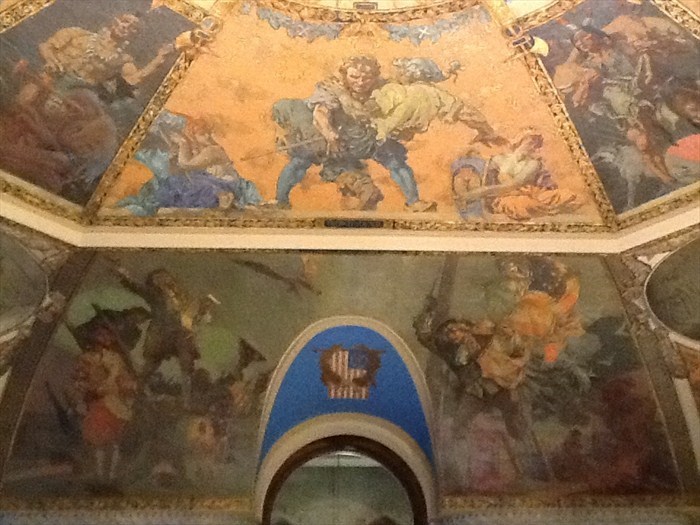
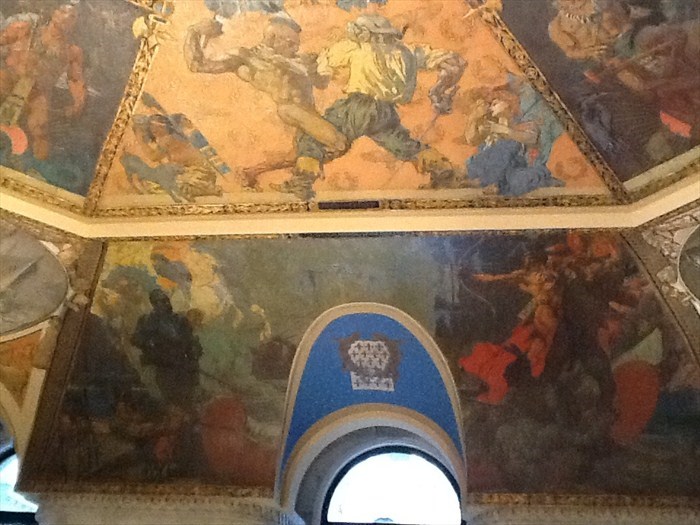
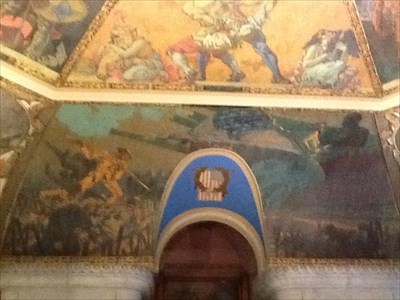
10 Gettysburg The Battle of Gettsburg (July 1-3, 1863) is considered by many historians to be the turning point of the American Civil War. This panel commemorates New York's participation in the conflict. Approximately 23,000 New York State soldiers fought at Gettysburg. New York regiments suffered the greatest number of casualties of any Northern state during the three-day battle. The inset flag is the Confederal Naval ensign. It probably was not carried in the field of Gettysburg because the white background could easily be confused with a flag of truce.
11 First American Flag at Fort Stanwix Fort Stanwix was built in 1758 to guard the Oneida Carry, a strategic portage along the Mohawk River. It is located near Rome, New York, 35 miles east of Syracuse. During the American Revolution, British forcesfailed to take the fort. When American militia and Oneida Indian allies tried to come to the aid of Fort Stanwix, they were ambushed at oriskany, one of the bloodiest engagements of the war. Many believe that these events directly contributed to the American victory in 1777. On the left-hand side of the painting, a man reads a document that could represent the Declaration of Independence. The man on the right raises the American flag over the fort, and behind him are two Indians, perhaps symbolizing the Oneida allies. A version of a Revolutionary era flag, one center star within a circle of 12, is portrayed here.
12 New France's First Battle with the Iroquois Invited by their Heron allies, Samuel de Champlain and two other French explorers met a band of Mohawk Indians near Ticonderoga, north of present-day Albany. As approximately 200 armored Mohawks emerged from their camp, Champlain took aim and killed one of the three Mohawk chiefs with a catchlock musket. This event was the Iroquois' first encounter with firearms. Acoompanying this mural isa flag representing French rule, depicting a gold fleur-de-lis on a white field. Tis pattern was the royal banner of the French kings.
13 New york Troops in the World War Approximately two million American soldiers went to France during 1917 and 1918 as members of the American Expeditionary Force (AEF). This mural commemorates those New Yorkers who served. A 46-star flag with an 8-7-8 8-7-8 pattern is shown beneath, although the 48-star flag was adopted in 1912 when Arizona and New Mexico were granted statehood. In the painting, men from both sides lie in trenches, while huge naval guns fire into the sky overhead. On the right, the Goddess of Victory marches over the battlefield carrying the American flag, impaling the German Kaiser with her sword. The battle depicted may be the breaking of the Hindenburg Line in France. The 27th division of the New York National Guard played a role in that battle.
City: Albany, NY

Location Name: NY State Capitol Building

Artist: Dodge, William deLeftwich

Date: 1928

Media: Oil paint on canvas, on plaster surface (except the flags which are oil on plaster)

Relevant Web Site: [Web Link]

|
Visit Instructions:
Please give the date and description of your visit. One original photo of the mural must also be submitted. GPSr photo NOT required.
|